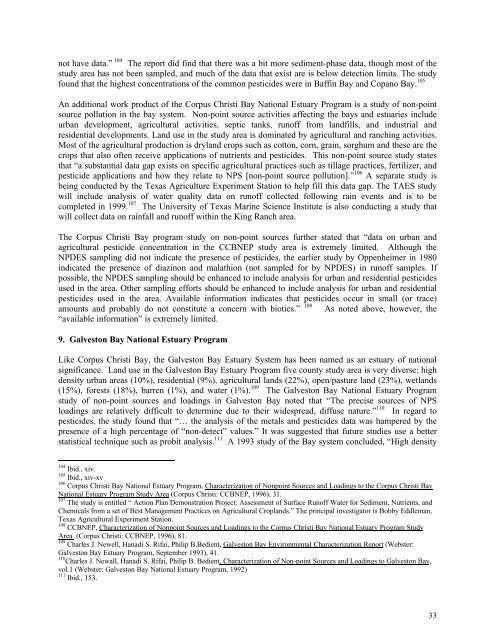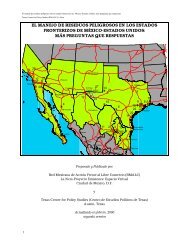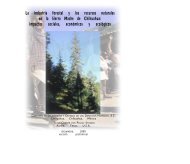Pesticides and Water Quality - Texas Center for Policy Studies
Pesticides and Water Quality - Texas Center for Policy Studies
Pesticides and Water Quality - Texas Center for Policy Studies
You also want an ePaper? Increase the reach of your titles
YUMPU automatically turns print PDFs into web optimized ePapers that Google loves.
not have data.” 104 The report did find that there was a bit more sediment-phase data, though most of thestudy area has not been sampled, <strong>and</strong> much of the data that exist are is below detection limits. The studyfound that the highest concentrations of the common pesticides were in Baffin Bay <strong>and</strong> Copano Bay. 105An additional work product of the Corpus Christi Bay National Estuary Program is a study of non-pointsource pollution in the bay system. Non-point source activities affecting the bays <strong>and</strong> estuaries includeurban development, agricultural activities, septic tanks, runoff from l<strong>and</strong>fills, <strong>and</strong> industrial <strong>and</strong>residential developments. L<strong>and</strong> use in the study area is dominated by agricultural <strong>and</strong> ranching activities.Most of the agricultural production is dryl<strong>and</strong> crops such as cotton, corn, grain, sorghum <strong>and</strong> these are thecrops that also often receive applications of nutrients <strong>and</strong> pesticides. This non-point source study statesthat “a substantial data gap exists on specific agricultural practices such as tillage practices, fertilizer, <strong>and</strong>pesticide applications <strong>and</strong> how they relate to NPS [non-point source pollution].” 106 A separate study isbeing conducted by the <strong>Texas</strong> Agriculture Experiment Station to help fill this data gap. The TAES studywill include analysis of water quality data on runoff collected following rain events <strong>and</strong> is to becompleted in 1999. 107 The University of <strong>Texas</strong> Marine Science Institute is also conducting a study thatwill collect data on rainfall <strong>and</strong> runoff within the King Ranch area.The Corpus Christi Bay program study on non-point sources further stated that “data on urban <strong>and</strong>agricultural pesticide concentration in the CCBNEP study area is extremely limited. Although theNPDES sampling did not indicate the presence of pesticides, the earlier study by Oppenheimer in 1980indicated the presence of diazinon <strong>and</strong> malathion (not sampled <strong>for</strong> by NPDES) in runoff samples. Ifpossible, the NPDES sampling should be enhanced to include analysis <strong>for</strong> urban <strong>and</strong> residential pesticidesused in the area. Other sampling ef<strong>for</strong>ts should be enhanced to include analysis <strong>for</strong> urban <strong>and</strong> residentialpesticides used in the area. Available in<strong>for</strong>mation indicates that pesticides occur in small (or trace)amounts <strong>and</strong> probably do not constitute a concern with biotics.” 108 As noted above, however, the“available in<strong>for</strong>mation” is extremely limited.9. Galveston Bay National Estuary ProgramLike Corpus Christi Bay, the Galveston Bay Estuary System has been named as an estuary of nationalsignificance. L<strong>and</strong> use in the Galveston Bay Estuary Program five county study area is very diverse: highdensity urban areas (10%), residential (9%), agricultural l<strong>and</strong>s (22%), open/pasture l<strong>and</strong> (23%), wetl<strong>and</strong>s(15%), <strong>for</strong>ests (18%), barren (1%), <strong>and</strong> water (1%). 109 The Galveston Bay National Estuary Programstudy of non-point sources <strong>and</strong> loadings in Galveston Bay noted that “The precise sources of NPSloadings are relatively difficult to determine due to their widespread, diffuse nature.” 110 In regard topesticides, the study found that “… the analysis of the metals <strong>and</strong> pesticides data was hampered by thepresence of a high percentage of “non-detect” values.” It was suggested that future studies use a betterstatistical technique such as probit analysis. 111 A 1993 study of the Bay system concluded, “High density104 Ibid., xiv.105 Ibid., xiv-xv106 Corpus Christi Bay National Estuary Program, Characterization of Nonpoint Sources <strong>and</strong> Loadings to the Corpus Christi BayNational Estuary Program Study Area (Corpus Christi: CCBNEP, 1996), 31.107 The study is entitled “ Action Plan Demonstration Project: Assessment of Surface Runoff <strong>Water</strong> <strong>for</strong> Sediment, Nutrients, <strong>and</strong>Chemicals from a set of Best Management Practices on Agricultural Cropl<strong>and</strong>s.” The principal investigator is Bobby Eddleman,<strong>Texas</strong> Agricultural Experiment Station.108 CCBNEP, Characterization of Nonpoint Sources <strong>and</strong> Loadings to the Corpus Christi Bay National Estuary Program StudyArea (Corpus Christi: CCBNEP, 1996), 81.109 Charles J. Newell, Hanadi S. Rifai, Philip B.Bedient, Galveston Bay Environmental Characterization Report (Webster:Galveston Bay Estuary Program, September 1993), 41.110 Charles J. Newall, Hanadi S. Rifai, Philip B. Bedient, Characterization of Non-point Sources <strong>and</strong> Loadings to Galveston Bay,vol.1 (Webster: Galveston Bay National Estuary Program, 1992)111 Ibid., 153.33




